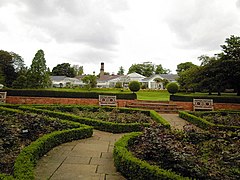Birmingham Botanical Gardens
| Birmingham Botanical Gardens (United Kingdom) | |
|---|---|
 |
|
| Location | Edgbaston, Birmingham, England |
| Coordinates | 52°27′59″N 1°55′45″W / 52.46652°N 1.9293°WCoordinates: 52°27′59″N 1°55′45″W / 52.46652°N 1.9293°W |
| Created | 1832 |
| Website | birminghambotanicalgardens |
The Birmingham Botanical Gardens is a 15 acres (6.1 hectares) botanical gardens situated in Edgbaston, Birmingham, England. The gardens are close to the centre of Birmingham and open every day except Christmas Day and Boxing Day. They are located at grid reference SP049854. It is an independent educational charity. The gardens are located just one and a half miles from the centre of Birmingham.
The gardens were designed in 1829 by J. C. Loudon, a leading garden planner, horticultural journalist and publisher and opened to the public on 11 June 1832.
The layout of the Botanical Gardens has changed very little since Loudon first designed it. There are four glasshouses which range from the exotic Tropical glasshouse, through to the Subtropical, Mediterranean and Arid houses. A large lawn is located in front of the glasshouses with a range of beds and shrubberies around its perimeter. Overall, the character is that of a Victorian public park with a bandstand set in 15 acres (6.1 ha) of landscaped greenery.
The gardens contain over 7,000 different plants and are home to The British National Bonsai Collection. One of the oldest specimens is the "Omiya tree", a 250-year-old Juniperus chinensis in the informal upright style, presented to the collection in 1995 by the then city of Omiya, Japan. There are many unusual and notable plants in the gardens including two fine Himalayan Cedars close to the fountain. These were raised from seeds given to the gardens in the 1840s by James Watt Junior - son of James Watt whose improvements to the Newcomen steam engine were fundamental to the changes brought by the Industrial Revolution. A plant found nowhere else is the fern Dicksonia ×lathamii which is a hybrid between Dicksonia antarctica and Dicksonia arborescens, raised by ex-Curator W. B. Latham more than one hundred years ago.
...
Wikipedia
